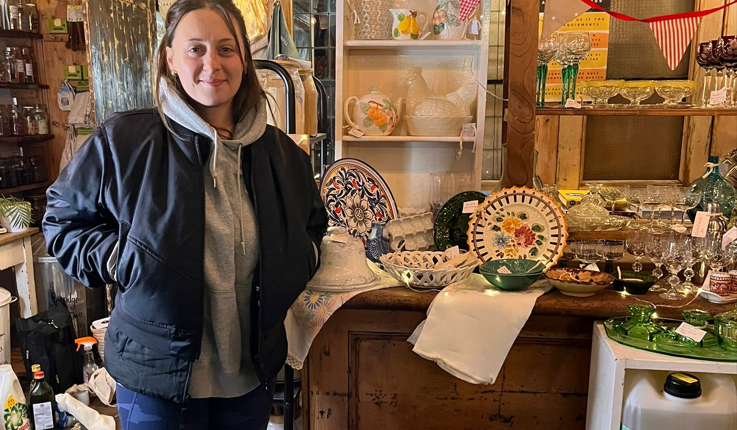MUM-OF-ONE Hannah Eichler makes around £400 a month from her crockery reselling side hustle, helping to boost the family budget.
She finds hidden gems at local charity shops and car boot sales and sells them on for more.
The 37-year-old, who lives in Leighton Buzzard, Bedfordshire, with her partner Jake and nine-month-old son Beau, runs The Crockery Lady and is on Instagram @thecrockerylady.
As Hannah comes from a family of antique dealers and has been visiting antique fairs and boot sales since she was a child.
“My mum had an antiques shop and one room of our home was always filled with old stuff,” she said.
“For a time, I only wanted brand new things from Ikea – and to live in a modern house. But now, in my 30s, I’ve come full circle.”


Hannah has picked up lots of tips from her parents on where to go to hunt for a bargain.
She said: “As well as charity shops and boot sales, I also go to flea markets, and even find things on Facebook Marketplace.
“I’m always scouring for vintage and preloved tableware, such as pots, plates, glasses, jugs and vases, which I buy for a few quid, and can then sell on for a profit.”
As well as shopping locally, the reselling aficionado also hunts out vintage stores when she is on holiday.
Most read in Money
She said: “I’ve been to second-hand shops all over Wales, along the south coast and in the Lake District.”
Hannah mostly sells to local people via Instagram and Facebook Marketplace, both of which allow you to list items for free.
Vinted is another reselling platform where it’s free to list items and sites such as Gumtree and Preloved will let you list for free, with the option to pay a fee to make your items more visible.
If you want to go a bit more pro, selling on platforms such as Etsy and Depop will mean paying a fee and even eBay will charge if you sell a lot of items.
Of course, there’s also the good old-fashioned face-to-face sales.
“Since December I’ve been doing pop-up shops,” says Hannah.
“In April this year, my mum and I teamed up to do one together. We even had a DJ and a coffee cart.
“With that event, I made a huge £700 in profit across three days. This was an exceptional amount.”
In a normal week, Hannah can typically earn around £100 in profit.
“But the income is unpredictable,” she said.
“My profit margins are super small but by making lots of small sales, the earnings do mount up. Plus this means I have a quick turnover of stock.”
It’s important to remember that if you’re making a profit from your side hustle, there could be tax implications.
Everyone is entitled to earn £12,570 a year before paying tax under the personal allowance.
You can also earn up to an extra £1,000 a year tax-free under the trading allowance.
If you earn more than this, you will have to fill in a self-assessment tax return and declare your income to HMRC.
They’ll calculate how much tax you owe and tell you how to pay.
Speedy sales
Hannah says that some items sell very quickly.
“Pieces of Portuguese pottery sell in minutes,” she said. “I once sold a plate in just 30 seconds.”
For the charity shop whizz, this money-making hobby feels more like a part-time job, as she spends a few hours almost every day either hunting for items, listing them or posting them.
Hannah said: “For example, a typical Sunday for me involves getting up early and making a trip to two boot sales.”
Hannah’s main job is in fashion, although she is currently on maternity leave.
“Before I left work to have Beau, I was doing both my day job and reselling at the same time which was a juggle,” she said.
“It’s a bit easier now I’m on maternity leave, but it’s still very time-consuming and as a big part of my business is social media, I never really get to switch off.”
For Hannah, her side hustle is something she’s willing to work hard for.
“I call it a paying hobby and I love it,” she said. “I’ve met so many amazing people through doing it – and especially other small business owners in my local community.
“For me, second-hand shopping is about saving money and nabbing a deal, but also about feeling part of a community.”
Where it started
Hannah turned her hand to reselling when she was working from home during the pandemic. During this period, she scoured the charity shops during her lunch break.
She said: “At first, I didn’t do it for the money, I just loved finding individual pieces – they really cheered me up.”
As time went by, with Hannah posting pictures of her finds on Instagram, she realised there were a lot of other people wanting to buy vintage, but who couldn’t afford to pay full price.
She said: “This gave me the idea of purchasing cool crockery on the cheap, and then selling pieces on to make a profit. Everything I look for has loads of personality and is a bit of fun.”
Recent successes for Hannah include a Portuguese cabbage leaf which she bought at a charity shop for £2.50 and sold on for £16.
“This was a good mark-up,” she said. “I also did well with a set of six hen egg cups which I got for £5, and then sold on Instagram for £15.”
As Hannah has discovered, there’s potentially some good money to be made from her hobby right now, as households increasingly choose to buy second hand items to help get through the cost-of-living crisis.
As demand for preloved items grows, here are Hannah’s top tips for reselling crockery and homeware.
Choose brands you know will sell well
One of the first rules is to choose brands you know will be popular.
“Any items of Carlton homeware, or pieces made in Italy or Portugal usually sell well,” she said.
“These tend to be really good quality items.”
Get to know the items that sell well
Over time, Hannah has developed a clearer idea of what people want to buy.
The key, she says, is to look for pieces you can pick up for very little, and then resell for a decent amount.
“Cabbage plates and anything fish-related are usually a good bet,” she said.
“People also love candlesticks and salad bowls.”
Check items carefully before buying
When you’re at a charity shop or boot sale, Hannah advises buying with your hands as well as your eyes.
She said: “Inspect everything for chips or cracks.”
Remember that items might not shift
With reselling, bear in mind you will only make money if someone wants to buy the goods you are selling.
“There are no guarantees,” adds Hannah.
“That said, sometimes the pieces I make the biggest gambles on are the ones that sell the best.”
Plan your shopping trips
Hannah recommends targeting areas with a high density of charity shops.
“Then, once you’re in a shop, go around twice,” she said. “Sometimes you uncover pieces you didn’t see the first time.”
Think about your pricing
As a general guide, Hannah looks to price items at double the amount she paid for them.


“Say I bought a bowl for £3, I’ll try to sell it for £6.”
Get buyers to pay for postage
Hannah says: “I get my customers to pay postage fees. I also keep costs low by recycling packaging as much as I can. If, for example, I order something from Amazon, I’ll try to re-use the box.”













